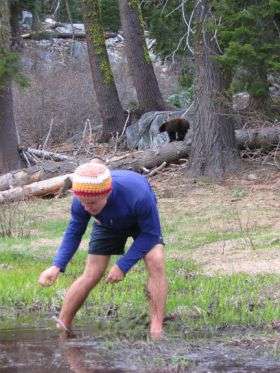Researchers Sometimes Encounter What They're Not Looking For

When researchers from the Sharon Lawler lab, Department of Entomology, University of California, Davis, hike into the wilds to do ecological research, sometimes they feel as if they're being watched.
And they are. By black bears. Max Joseph, a wildlife, fisheries and conservation biology major and a student assistant in the Lawler lab, was working on a frog survey on May 11 at Adams Lake in the 513,100-acre Trinity Alps Wilderness, when he encountered a young black bear.
"Initially we were quite concerned, or at least I was, considering that I was on the other side of the lake when the bear was first seen 40 feet or so away from Sharon while she was conducting her eggmass survey," Joseph said.
"The bear was there for 20 or 30 minutes, seemingly disinterested in us," he said. "He was mostly rooting around and foraging."
Lawler, an ecologist, mosquito control researcher and associate professor of entomology, snapped a digital photo of her student wading in the lake, with the bear behind him. The "Max-and-the-bear" photo shows him calming counting frog eggs, while the equally calm black bear forages.
"The bears in the Trinities are quite afraid of humans, unlike those of the Sierra, so most people do not bother with carrying bear spray or bear bells," Joseph said.
Lawler described the bear as a "yearling" and "wary but calm."
"It returned to grazing once we had finished the survey in its vicinity. We enjoyed seeing the bear, but we watched and listened carefully for about 10 minutes to make sure that it wasn't still being accompanied by its mother, and we did not approach the bear."
"We did see a mother bear and her cub at a different lake the next week, but fortunately, she was shy and ran off quickly."
The Lawler lab is researching how introduced trout affect aquatic insects and native amphibians, especially the declining Cascades frog (Rana cascadae). "Because amphibians and aquatic insects have a terrestrial phase in their lives, we also survey the snakes and birds that feed on frogs and emerging insects," she said.
"We regularly see all sorts of wildlife in the Trinities, including deer, raptors and many other kinds of birds, bats, snakes, frogs, salamanders, and even a pine marten," Lawler said. "Pine marten were unknown to that area prior to our surveys."
The researchers always travel in groups of two or three and do not approach potentially dangerous animals. "The only animals in the Trinities that are dangerous are rattlesnakes, mountain lions, and bears," said Lawler. "Of course, with wild mammals there is always a slight risk of rabies or other infectious disease. We try to disturb animals as little as possible as part of the wilderness ethic, although we do have to tag frogs and snakes for research."
Joseph said he's seen a variety of wildlife this season, including frogs, treefrogs, toads, deer, red-tailed hawks, woodpeckers and turkey vultures.
And now, bears.
Source: UC Davis





















